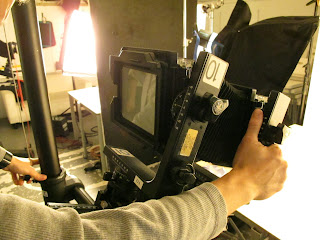Friday 07th Oct 2011
10:00 Talk on Perspective and Focal Length: James Smith (Standing in for Jonathan) and Steve
10:45 Perspective and Focal Length workshop (with support from James Smith and Steve)
I already had a pretty good understanding of focal length (the measured distance between the film or sensor and the centre line of the optical lens), and I understood how focal length and perspective affected an image. I was also aware perspective could be corrected in the large format 4x5 camera, although I'd never seen it done or attempted it myself.
For this exercise I once again teamed up with my study partner Ian Turner and we set about building our set and setting up the flash and camera equipment. As previously we bought more film than was required, taking the attitude that more practice and hands on experience was worth the extra expense. I guess the main learning points for me related to understanding which part of the camera influenced focus (via adjusting/tilting the focal plane), this is the front standard and obviously the lens! With the rear standard being used to correct perspective by adjusting/tilting as required.
I liked the way you could twist the back for creative effect and I used this method on the final of my three colour images.
Ian shot his B&W through to use as proofs. We switched between a 240mm, and 180mm lens during the course of the day to complete the exercises: Which included: Shooting two images (of our own objects) and switching lenses to see the compression created within an image by changing the lens and focal length; Adjusting to correct the focal plane to ensure sharpness on a vertical plane, adjusting the back plate to correct merging vertical lines (whilst shooting a book as a subject).
I liked the simple hints and tips given during the day such as: "looking through the corners of the glass plate, if you can see the lens, your correction isn't to extreme (and as a rule of thumb), and should suffer no vignetting" "Remember the light passing through the lens is creating a circular image cropped within the camera body, move the rear plate too far and you move the film outside of light. Thus creating vignetting" "try and shoot straight on or at 45 degrees or it can be very complex to make the corrections to the perspective"
I can really see the reasons why people love and use these cameras, and I have warmed to them myself
This time I found handling the film in the dark room far easier and everything processed without any issues. I shot and processed three colour images. I also processed the two B&W proof shots I'd taken on the previous 4x5 exercise, that I'd run out of time to develop (using Ian's proofs to save time thus ensuring we both had colour prints from the previous session)
Although no mention was made of publishing the presentation I hope this will be done as it was very effective at visualising the way the camera could be used.




No comments:
Post a Comment